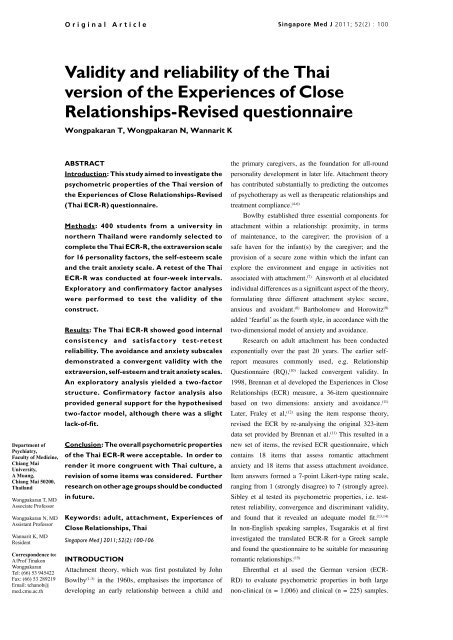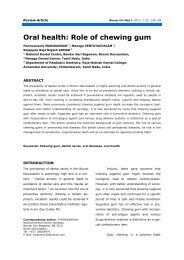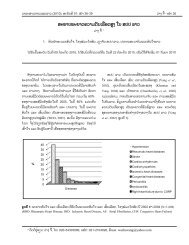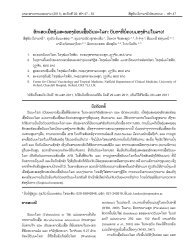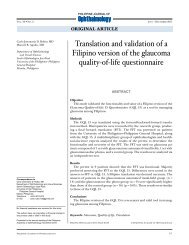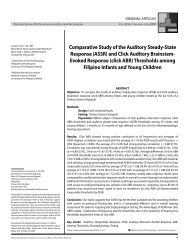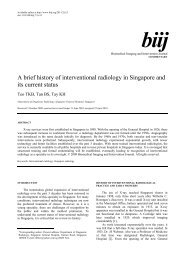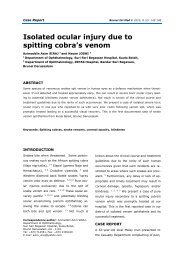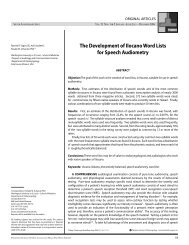Validity and reliability of the Thai version of the ... - ResearchGate
Validity and reliability of the Thai version of the ... - ResearchGate
Validity and reliability of the Thai version of the ... - ResearchGate
Create successful ePaper yourself
Turn your PDF publications into a flip-book with our unique Google optimized e-Paper software.
Singapore Med J 2011; 52(2) : 103<strong>the</strong> following steps: (a) The first author translated <strong>the</strong>original English <strong>version</strong> <strong>of</strong> <strong>the</strong> ECR-R into <strong>Thai</strong>, followedby an item-by-item comparison; (b) A bilingual person(an English-<strong>Thai</strong> school teacher), who had not beenexposed to <strong>the</strong> original ECR-R, did <strong>the</strong> back-translationinto English. Cultural adaptations <strong>and</strong> comparisons <strong>of</strong>reading difficulty were checked; (c) The original <strong>and</strong><strong>the</strong> new English <strong>version</strong>s were compared <strong>and</strong> reviewedby consensus (comprising a bilingual psychologist <strong>and</strong><strong>the</strong> authors). A few disagreements were found, so <strong>the</strong>process outlined above was repeated with <strong>the</strong>se items.All 36 translated items were accepted by consensus in <strong>the</strong>second revision. A field trial was <strong>the</strong>n carried out with 30students; <strong>and</strong> (d) Anomalies in <strong>the</strong> results were flagged,<strong>and</strong> a final revision was made to make minor changes orcorrect printing errors.All instruments were completed by r<strong>and</strong>omly selectedstudent participants who gave <strong>the</strong>ir written consent.Six weeks later, <strong>the</strong> <strong>Thai</strong> ECR-R was administered <strong>and</strong>completed by 136 participants. We investigated <strong>the</strong> factorstructure by exploratory factor analysis <strong>and</strong> principalcomponent with oblique rotation. During <strong>the</strong> sixweekretest period, to assess <strong>the</strong> model fit, we adoptedconfirmatory factor analysis with <strong>the</strong> retest group using<strong>the</strong> criteria recommended by Hu <strong>and</strong> Bentler. (27)RESULTSThe mean age <strong>of</strong> <strong>the</strong> samples was 20.36 ± 2.0 (range18–34) years. The male:female ratio was 143 (36%):257 (64%). 33% <strong>of</strong> participants were in a relationshipat <strong>the</strong> time <strong>of</strong> <strong>the</strong> study, with <strong>the</strong> period <strong>of</strong> relationshipranging from 1–133 (mean 28.38 ± 25.09, mode 24.50)months. The mean anxiety subscale for <strong>the</strong> <strong>Thai</strong> ECR-Rwas 3.46 ± 0.99, <strong>and</strong> avoidance was 2.89 ± 0.95. Therewas no significant gender difference in <strong>the</strong> avoidance oranxiety scores, no correlation between age <strong>and</strong> <strong>the</strong> <strong>Thai</strong>ECR-R score <strong>and</strong> no gender difference in <strong>the</strong> distribution<strong>of</strong> <strong>the</strong> attachment style. The distribution <strong>of</strong> <strong>the</strong> romanticattachment style <strong>of</strong> <strong>the</strong> Chiang Mai University samplewas as follows: secure 57.6%, preoccupied 14.4%, fearful4.3% <strong>and</strong> dismissing 23.7%. The fearful style was moreprevalent in male participants, while a preoccupied stylewas more prevalent in female participants.The mean <strong>and</strong> st<strong>and</strong>ard deviation <strong>of</strong> each item rangedfrom 2.27 ± 1.25 to 5.34 ± 1.55. To ensure univariatenormality, Kline (28) suggested cut-<strong>of</strong>f points <strong>of</strong> <strong>the</strong>absolute values <strong>of</strong> 3.0 <strong>and</strong> 8.0 for skew <strong>and</strong> kurtosis,respectively. The skew <strong>of</strong> <strong>the</strong> <strong>Thai</strong> ECR-R for <strong>the</strong> 36items ranged from −0.839 to 0.757, while <strong>the</strong> values forkurtosis ranged from −0.051 to 0.513, indicating that <strong>the</strong>responses followed a normal distribution. Factor analysis,using unrotated principal component analysis, extractedsix components that explained 57.25% <strong>of</strong> <strong>the</strong> variance(Eigenvalues > 1), while 41% was accounted for by twocomponents. Oblique rotation (delta = 0) was applied, <strong>and</strong>each factor explained <strong>the</strong> same cumulative percentage<strong>of</strong> variances. Although six factors with Eigenvalues > 1were extracted, <strong>the</strong>re was a steeply decreasing trend after<strong>the</strong> second factor. This suggested a tendency to favour atwo-factor model. Items 12 <strong>and</strong> 18 in <strong>the</strong> anxiety subscalewere found to be outliers.The second principal component analysis, forcingtwo factors with oblique rotation (delta = 0) <strong>and</strong> Kaisernormalisation, was performed. This resulted in all itemsbeing loaded on <strong>the</strong> designated scales. However, items13 <strong>and</strong> 6 <strong>of</strong> <strong>the</strong> avoidance subscale, as well as items 20,12, 18 <strong>and</strong> 5 <strong>of</strong> <strong>the</strong> anxiety subscale, had loadings greaterthan 0.30 above o<strong>the</strong>r factors. The loading was 0.31–0.77for <strong>the</strong> anxiety subscale <strong>and</strong> 0.38–0.77 for <strong>the</strong> avoidancesubscale. (Table I). Table I shows <strong>the</strong> original <strong>version</strong><strong>and</strong> <strong>the</strong> <strong>Thai</strong> <strong>version</strong> <strong>of</strong> <strong>the</strong> ECR-R. All items had higherloading on <strong>the</strong>ir intended factor; however, item 17 on <strong>the</strong>avoidance factor, <strong>and</strong> items 12, 18 <strong>and</strong> 5 on <strong>the</strong> anxietyfactor had a high loading <strong>of</strong> o<strong>the</strong>r factors as well. Someitems were assumed to be loaded on <strong>the</strong> third factor, i.e.items 10, 12, 18, 20, 21, 25 <strong>and</strong> 28. Interestingly, all seven<strong>of</strong> <strong>the</strong>se items seemed to address extraneous content suchas anger, closeness <strong>and</strong> self-doubt.During <strong>the</strong> six-week retest period, 136 participantscompleted <strong>the</strong> questionnaire. The mean age <strong>of</strong> <strong>the</strong>participants was 19.69 ± 0.72 (range 18–25) years.The male:female ratio was equal, at 68 each. The meananxiety subscale <strong>of</strong> <strong>the</strong> retest group was 3.29 ± 1.02 <strong>and</strong><strong>the</strong> avoidance was 2.89 ± 0.80. There were no significantgender differences in terms <strong>of</strong> <strong>the</strong> avoidance or anxietyscores. To explore <strong>the</strong> model fit <strong>of</strong> <strong>the</strong> structural equationby confirmatory factor analysis, data collected during thisperiod was analysed. The raw data was used to create acovariance matrix, <strong>and</strong> maximum likelihood estimationwas employed to estimate <strong>the</strong> parameters <strong>of</strong> <strong>the</strong> model<strong>and</strong> fit indices. Maximum likelihood was used becauseit produces more accurate fit indices <strong>and</strong> less biasedparameters than <strong>the</strong> generalised least squares estimation.(29)The st<strong>and</strong>ardised path coefficients in <strong>the</strong> two-factorsolution was 0.14–0.82 for items assessing avoidance, <strong>and</strong>0.27–0.83 for those assessing anxiety. These two latentfactors correlated at 0.27, <strong>and</strong> R 2 was 0.07–0.70 (seeTable II).The level <strong>of</strong> fit <strong>of</strong> <strong>the</strong> model was examined usingseveral fit indices. A lack-<strong>of</strong>-fit or poor fit indicatesmisspecification. Based on our investigation <strong>of</strong> <strong>the</strong>sensitivity <strong>of</strong> various fit indices, <strong>the</strong> following absolute fit
Singapore Med J 2011; 52(2) : 105similar to that previously reported by Ciechanowskiet al. (33) The <strong>Thai</strong> ECR-R showed acceptable internalconsistency, test-retest <strong>reliability</strong>, construct <strong>and</strong>convergent validity. The factors extracted in our studycoincided with <strong>the</strong> study <strong>of</strong> Tsagarakis et al, (15) whereseven factors initially accounted for 60% <strong>of</strong> <strong>the</strong> variance.Their study was <strong>the</strong> first investigation in a non-Anglo-Saxon language <strong>and</strong> cultural context, <strong>and</strong> it was found tobe suitable in terms <strong>of</strong> psychometric properties. Our studyyielded similar results, confirming that <strong>the</strong> translatedECR-R still possesses acceptable <strong>reliability</strong> <strong>and</strong> validitywithin a different culture. The mean figures for <strong>the</strong> <strong>Thai</strong>ECR-R were avoidance 2.89 ± 0.95 <strong>and</strong> anxiety 3.46 ±0.99, while in <strong>the</strong> original study by Tsagarakis et al, <strong>the</strong>avoidance score was 3.02 ± 0.93 <strong>and</strong> <strong>the</strong> mean scoreG-ECR-R for anxiety was 3.60 ± 1.04. (15)With regard to <strong>the</strong> model’s fit, we found both good<strong>and</strong> poor indices. Besides a relatively small sample size,a model’s lack-<strong>of</strong>-fit may be attributed to some items thataddressed extraneous content, which do not effectivelyrepresent <strong>the</strong> latent construct for which <strong>the</strong>y were written.However, <strong>the</strong> two-factor model was significantly moreappropriate than <strong>the</strong> single-factor model, while <strong>the</strong>re wasno difference between models with two factors <strong>and</strong> thosewith more than two factors. Thus, it could be concludedthat <strong>the</strong> two-factor model was <strong>the</strong> most relevant to <strong>the</strong>hypo<strong>the</strong>sised model. Although <strong>the</strong> model fit did not yield asatisfactory result, <strong>and</strong> thus requires fur<strong>the</strong>r investigation,we discuss some hypo<strong>the</strong>ses for <strong>the</strong> lack-<strong>of</strong>-fit here.The inappropriate values <strong>of</strong> SRMR <strong>and</strong> NFI indicatedboth simple <strong>and</strong> complex model misfits, <strong>and</strong> <strong>the</strong>se maybe explained by large, st<strong>and</strong>ardised residuals, which ledto item sharing (i.e. items 12 <strong>and</strong> 3) or low R 2 values(e.g. items 5, 9, <strong>and</strong> 23 for <strong>the</strong> anxiety factor <strong>and</strong> items11, 13, 17 <strong>and</strong> 24 for <strong>the</strong> avoidance factor). These itemswere poorly associated with <strong>the</strong> underlying dimension <strong>and</strong>failed to contribute to <strong>the</strong> scale. In addition, some multidimensionalitems also had an impact on <strong>the</strong> level <strong>of</strong> fit.Interestingly, our results support <strong>the</strong> recent studycarried out by Lo et al, (34) in which <strong>the</strong>y found that <strong>the</strong>items that caused <strong>the</strong> model’s lack-<strong>of</strong>-fit were similar.In Lo et al’s study, a higher-order factor analysis <strong>of</strong> amodified ECR was used. They found that <strong>the</strong> ‘discomfortwith closeness’ factor, which should represent anavoidance orientation, had a double-loading. This factorcomprised <strong>the</strong> items corresponding to our problematicitems, i.e. items 2, 3, 11, 17 <strong>and</strong> 24. In addition, <strong>the</strong> itemaddressed as extraneous content in Fairchild <strong>and</strong> Finney’sstudy (17) was found to play <strong>the</strong> same role in our study, i.e.item 12 (“I’m afraid that once a romantic partner gets toknow me, he or she won’t like who I really am”). Finally,a new set <strong>of</strong> 28-item questionnaire, as recommended bymodification indices, was re-analysed. Some items wereremoved from <strong>the</strong> new set to ease administration. Thesewere items 24, 17, 13 <strong>and</strong> 11 on <strong>the</strong> avoidance factor <strong>and</strong>items 23, 12, 9 <strong>and</strong> 5 on <strong>the</strong> anxiety factor. The resultsturned out an adequate model fit, as follows: CFI = 0.99,NFI = 0.86, RMSEA = 0.021, SRMR = 0.07.In summary, <strong>the</strong> <strong>Thai</strong> ECR-R demonstrates goodinternal consistency <strong>and</strong> fair-to-good test-retest <strong>reliability</strong>.The lack <strong>of</strong> fitness <strong>of</strong> <strong>the</strong> model suggests that some itemson <strong>the</strong> scale were inappropriate in <strong>the</strong> representation <strong>of</strong><strong>the</strong> constructs <strong>of</strong> anxiety <strong>and</strong> avoidance. Deleting someitems provided a better construct validity. A st<strong>and</strong>-aloneexamination <strong>of</strong> <strong>the</strong> 28-item ECR-R (or less items) shouldbe conducted, particularly with a more general sample <strong>of</strong><strong>the</strong> population.ACKNOWLEDGEMENTSThis research was funded by <strong>the</strong> Faculty <strong>of</strong> Medicine,Chiang Mai University, <strong>Thai</strong>l<strong>and</strong>. The authors wish tothank Assistant Pr<strong>of</strong> Dr Ruetinan Samuttai, Faculty <strong>of</strong>Education, Chiang Mai University <strong>and</strong> Dr NumchaiSuppareakchaisakul, Srinakharinwirot University,Bangkok for <strong>the</strong>ir suggestions regarding <strong>the</strong> confirmatoryfactor analysis <strong>and</strong> Lisrel programme.REFERENCES1. Bowlby J. Attachment <strong>and</strong> loss. Volume 2. Separation: Anxiety<strong>and</strong> anger. New York: Basic Books, 1973.2. Bowlby J. Attachment <strong>and</strong> loss. Volume 3. Loss: Sadness <strong>and</strong>depression. New York: Basic Books, 1980.3. Bowlby J. Attachment <strong>and</strong> loss. Volume 1. Attachment. 2ndedition. New York: Basic Books, 1982.4. Johnson LN, Ketring SA, Rohacs J, Brewer AL. Attachment <strong>and</strong><strong>the</strong> <strong>the</strong>rapeutic alliance in family <strong>the</strong>rapy. Am J Fam Ther 2006:34:205-18.5. Naaman S, Pappas JD, Makinen J, Zuccarini D, Johnson-DouglasS. Treating attachment injured couples with emotionally focused<strong>the</strong>rapy: a case study approach. Psychiatry 2005; 68:55-77.6. Parish M, Eagle MN. Attachment to <strong>the</strong> <strong>the</strong>rapist. PsychoanalPsychol 2003, 20:271-286.7. Bowlby J. The making <strong>and</strong> breaking <strong>of</strong> affectional bonds. London:Tavistock, 1979.8. Ainsworth MDS, Blehar MC, Waters E, Wall S: Patterns <strong>of</strong>Attachment: A Psychological Study <strong>of</strong> <strong>the</strong> Strange Situation. NewJersey: Hilldales, 1978.9. Bartholomew K, Horowitz LM. Attachment styles among youngadults: a test <strong>of</strong> a four-category model. J Pers Soc Psychol 1991;61:226-244.10. Bartholomew K, Griffin DW. The metaphysics <strong>of</strong> measurement:<strong>the</strong> case <strong>of</strong> adult attachment. In: Bartholomew, K <strong>and</strong> Perlman,D (Eds). Advances in Personal Relationships. London: JessicaKingsley, 1994;5:17-52.11. Brennan KA, Clark CL, Shaver PR. Self-report measures <strong>of</strong>adult romantic attachment. In: Attachment Theory <strong>and</strong> CloseRelationships J.A Simpson JA, Rholes WS, eds. New York:Guilford, 1998: 46-76.12. Fraley RC, Waller NG, Brennan KA. An item response <strong>the</strong>ory
Singapore Med J 2011; 52(2) : 106analysis <strong>of</strong> self-report measures <strong>of</strong> adult attachment. J Pers SocPsychol 2000; 78:350-65.13. Sibley CG, Fisher R, Liu JH. Reliability <strong>and</strong> validity <strong>of</strong> <strong>the</strong> revisedexperiences in close relationships (ECR-R) self-report measure<strong>of</strong> adult romantic attachment. Pers Soc Psychol Bull 2005;31:1524-36.14. Sibley CG, Liu JH. Short-term temporal stability <strong>and</strong> factorstructure <strong>of</strong> <strong>the</strong> revised experiences in close relationships (ECR-R)measure <strong>of</strong> adult attachment. Pers Individ Dif 2004; 36:969-75.15. Tsagarakis M, Kafetsios K, Stalikas A. Reliability <strong>and</strong> validity <strong>of</strong><strong>the</strong> Greek <strong>version</strong> <strong>of</strong> <strong>the</strong> revised experiences in close relationships(ECR-R) measure <strong>of</strong> adult attachment. Eur J Psychol Assess 2007;23:47-55.16. Ehrenthal JC, Dinger U, Lamla A, Funken B, SchauenburgH. [Evaluation <strong>of</strong> <strong>the</strong> German <strong>version</strong> <strong>of</strong> <strong>the</strong> attachmentquestionnaire “Experiences in Close Relationships--Revised”(ECR-RD)]. Psycho<strong>the</strong>r Psychosom Med Psychol 2009; 59:215-23. German.17. Fairchild A, Finney SJ. Investigating validity evidence for <strong>the</strong>experience in close relationships-revised questionnaire. EducPsychol Meas 2006; 66:116-35.18. Li T, Kato K. [Measuring adult attachment: Chinese adaptation<strong>of</strong> <strong>the</strong> ECR scale]. Acta Psychologica Sinica. 2006; 38:399-406.Chinese.19. Earls L, Huth-Bocks A. The Relationship between Personality<strong>and</strong> Adult Attachment. Available at: www.gradschool.emich.edu/downloads/downloads_subdir/resfair/2008_awrd_papers/earls,_psychology.pdf. Accessed September 3, 2010.20. Comrey AL, Lee HB. A First Course in Factor Analysis. Hillsdale:Lawrence Erlbaum, 1992.21. Spielberger CD, Gorsuch RC, Lushene RE. Manual for <strong>the</strong> State-Trait Anxiety Inventory. California: Consulting PsychologistsPress, 1970.22. Iamsupasit S, Phumivuthisarn P. A study <strong>of</strong> cognitive factorsrelated to anxiety sensitivity. In: Iamsupasit S, ed. Proceedings<strong>of</strong> <strong>the</strong> East-West Psychology Science Research Center. Bangkok,<strong>Thai</strong>l<strong>and</strong>, November 24-25, 2005. Available at: www.psy.chula.ac.th/east-west/proceeding/proceeding2005.pdf]. AccessedSeptember 4, 2010.23. Rosenberg M. Society <strong>and</strong> <strong>the</strong> adolescent self-image. Princeton:Princeton University Press, 1965.24. Beeber LB, Seeherunwong A, Schwartz T, Funk SG, VongsirimasN. <strong>Validity</strong> <strong>of</strong> <strong>the</strong> Rosenberg self-esteem scale in young womenfrom <strong>Thai</strong>l<strong>and</strong> <strong>and</strong> <strong>the</strong> USA. <strong>Thai</strong> J Nurs Res 2007; 11:240-50.25. Cattell RB, Eber HW, Tatsuoka MM. The H<strong>and</strong>book for <strong>the</strong>Sixteen Personality Factor Questionnaire. Champaign, IL:Institute for Personality Ability Testing, 1970.26. Chaupukdee P. The relationship between personality factor <strong>and</strong>practice outcome among nurses in Siriraj Hospital. Dissertation.Mahidol University, Graduate School, 1983.27. Hu L, Bentler PM. Cut <strong>of</strong>f criteria for fit indexes in covariancestructure analysis: conventional criteria versus new alternatives.Struct Equ Modeling 1999, 6:1-55.28. Kline RB. Principles <strong>and</strong> practice <strong>of</strong> structural equation modeling.New York: Guilford, 1998.29. Jöreskog KG, Sörbom D. LISREL 8 User’s Reference Guide.Chicago: Scientific S<strong>of</strong>tware International, 1993.30. Hu L, Bentler PM. Evaluating model fit. In: Structural EquationModeling: Concepts, Issues <strong>and</strong> Applications. Edited by HoyleRH. California: Sage, 1995:76-99.31. Hu L, Bentler PM. Fit indices in covariance structure modeling:Sensitivity to under-parameterized model misspecification.Psychol Methods 1998, 3:424-53.32. Jöreskog KG, Sörbom D. 3rd ed. LISREL VI User’s Guide.Mooresville: Scientific S<strong>of</strong>tware, 1984.33. Ciechanowski PS, Walker EA, Katon WJ, Russo JE. Attachment<strong>the</strong>ory: a model for health care utilization <strong>and</strong> somatization.Psychosom Med 2002; 64:660-7.34. Lo C, Walsh A, Mikulincer M, et al. Measuring attachmentsecurity in patients with advanced cancer: psychometric properties<strong>of</strong> a modified <strong>and</strong> brief Experiences in Close Relationships scale.Psychooncology 2009; 18:490-9.


